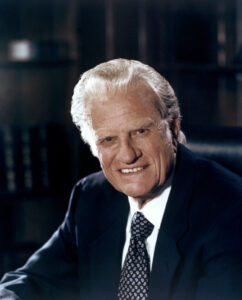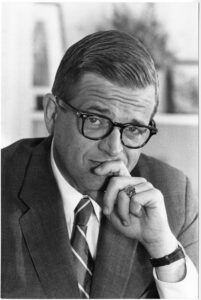
Two of evangelicalism’s most revered and respected men were Billy Graham and Chuck Colson. Billy Graham’s entire life can be summed up with two words — character and integrity. After years in the public eye and throughout his life, his character remained beyond reproach, and his reputation spotless. He never got off on a side street or spent time on the sidelines. Conversely, however, Chuck Colson’s life came crashing down like Jerusalem’s wall. He wandered off down several side streets and found himself on the sidelines in a prison cell. But then he came back and rebuilt a life of character and conviction. He left a legacy through his ministry of Prison Fellowship that served as Christ’s own hand extended, giving help and eternal hope to thousands of prisoners and their families. Colson and Graham have this in common — they both finished strong.
Starting strong


For decades, Billy Graham was one of the most recognized names in the entire English-speaking world. His preaching ministry burst onto the American scene while he was still a young man in the 1940s. However, he had two contemporaries, who, at the time, were much better known and promised to be much brighter stars on the national scene. But strangely, few people today have ever even heard of Chuck Templeton or Bron Clifford. In William Martin’s biography of Billy Graham, he related that Chuck Templeton was the most gifted and talented young preacher of his era.
Billy Graham, Chuck Templeton, and Bron Clifford were all greatly sought-after young preachers. IN 1946, the National Association of Evangelicals published an article entitled “The Best-Used Men of God.” That article highlighted the ministry of Chuck Templeton but made no mention of Billy Graham. Today, we have heard of Billy Graham, but whatever happened to Chuck Templeton and Bron Clifford?
Bron Clifford started out in the ministry at a young age. When he was only twenty-five, he was already preaching to massive crowds that numbered in the thousands. Met by overflow crowds everywhere he went, it was said that he had touched more lives and broke more attendance records than any evangelist in American history. He was tall and handsome, intelligent and eloquent. He soon caught the attention of Hollywood producers seeking to entice him to play significant roles in movies. That turned out to be a disastrous side street for him. By the mid-1950s, Clifford had lost his health and his family, and he was plagued by alcoholism. At the age of thirty-five, this great preacher died alone in a rundown motel room on the outskirts of Amarillo, Texas. Chuck Templeton also left the ministry but to pursue a career in journalism. Sadly, by the early 1950s, this once-gifted preacher of the Gospel was reported to no longer believe in Christ in the orthodox sense.
The moral? No matter how gifted one may or may not be, rebuilders have at least one characteristic in common: they finish strong. They don’t detour off onto side streets or allow themselves to be relegated to the sidelines.
Rebuilding what was broken
Chuck Colson, however, was the epitome of a rebuilder. Caught up in the cover-up of his own Watergate crimes, his walls collapsed and his gates burned down. He detoured off onto side streets and was relegated to the sidelines of prison. But he didn’t stay there; he came back. Years after his death, his presence was felt in Prison Fellowship gatherings around the world, giving hope and help to thousands who are also battling to rebuild their lives.
In the book of Nehemiah, chapter six, many of us are like him, seeking to rebuild something that has been broken. It has been a long journey for Nehemiah — from Persia, where he first heard the report of Jerusalem’s broken wall, to his leaving the comforts and security of his life as the king’s cupbearer, to becoming the rebuilder of the broken wall of Jerusalem. Much has changed since he made that solitary midnight ride to review the ruins. The wall was up, and Nehemiah had the finish line in sight. All that remained was to hang the gates (Nehemiah 6:1).
Seeing the finish line
At last, the goal was in sight — the finish line. “Mission Accomplished” is just ahead. But be warned: this is the most dangerous point in any rebuilding process. This is when the enemy comes along with one final attempt to divert us from our goal. The enemy first tried to detour Nehemiah onto a side street. But Nehemiah kept his focus and replied to that temptation with a question: “Why should the work cease while I leave it and go down to you?” (6:30. So then his enemies tried to relegate Nehemiah to the sidelines. But he remained faithful and fired off another question instead: “Should such a man as I flee?” (6:11)/
Of all the wonderful things one could say about Nehemiah, the best is this: he finished strong. And, before he steps off the scene of Scripture, he leaves us with a valuable lesson on how we can do the same. It is not so much how long our personal race may be, nor even how difficult the obstacles we face along the way, but it is how we finish that matters most.
Seeing the finish line ahead, Nehemiah sprinted toward the tape while shouting two important principles to us that keep echoing down through the corridors of the centuries: “Stay off the side streets. Keep focused! Stay off the sidelines. Keep faithful!” He wanted to ensure that it might be said of you and me, “So the wall was finished” (6:15). After all, it’s never too late for a new beginning.”
Taken from The Nehemiah Code by O.S. Hawkins. Copyright © 2018 by Dr. O.S. Hawkins. Used by permission of Thomas Nelson.
O.S. Hawkins is the chancellor of Southwestern Baptist Theological Seminary. He has served pastorates, including the First Baptist Church in Fort Lauderdale, Florida, and the First Baptist Church in Dallas, Texas, for more than 25 years. A native of Fort Worth, Texas, he has a BBA from Texas Christian University and his MDiv and Ph.D. from Southwestern Baptist Theological Seminary. For almost a quarter of a century, he served as president of GuideStone Financial Resources, with assets under management of $20 billion, serving 250,000 pastors, church staff members, missionaries, doctors, university professors, and other workers in various Christian organizations with their investment, retirement and benefit service needs. He is the author of more than 40 books and regularly speaks to business groups and churches nationwide. All of the author’s royalties and proceeds from the Code series support Mission:Dignity. You can learn more about Mission:Dignity by visiting MissionDignity.org.
Read more articles by Dr. O.S. Hawkins at: https://www.goodnewsfl.org/author/o-s-hawkins/

Comments